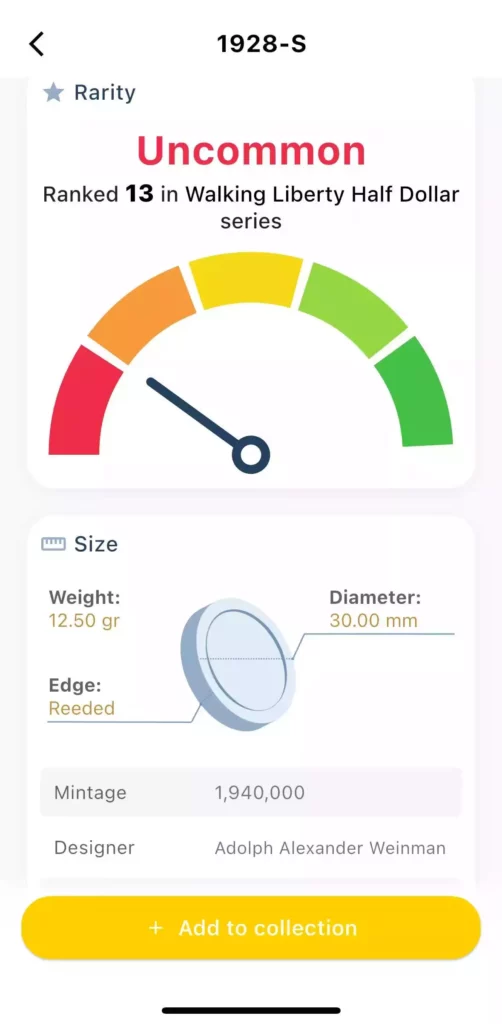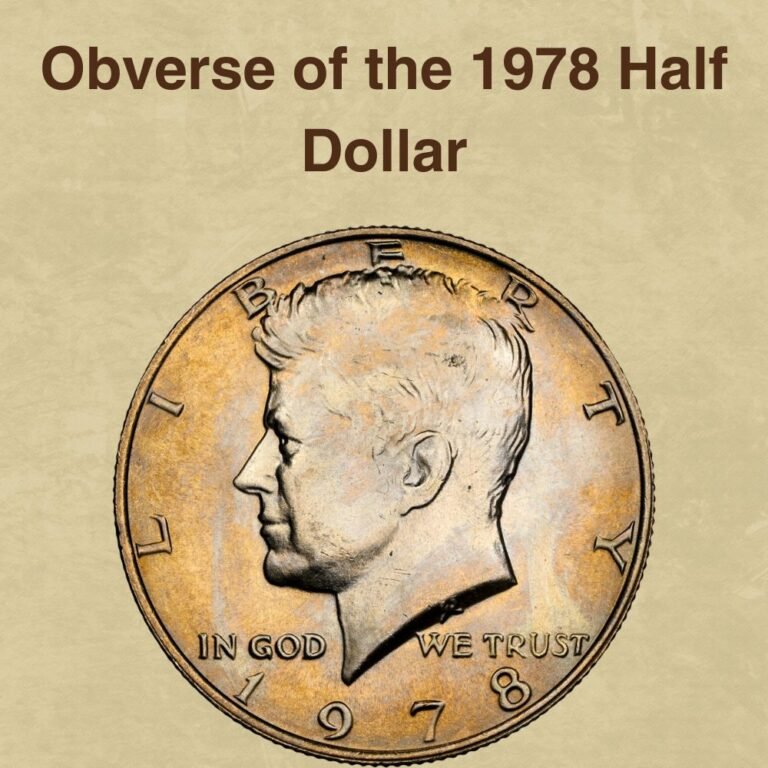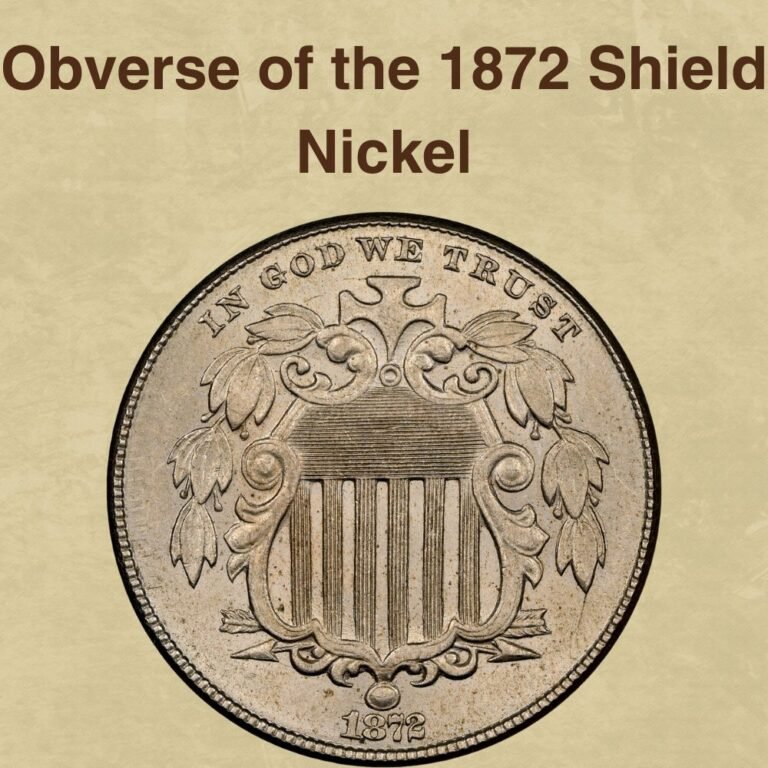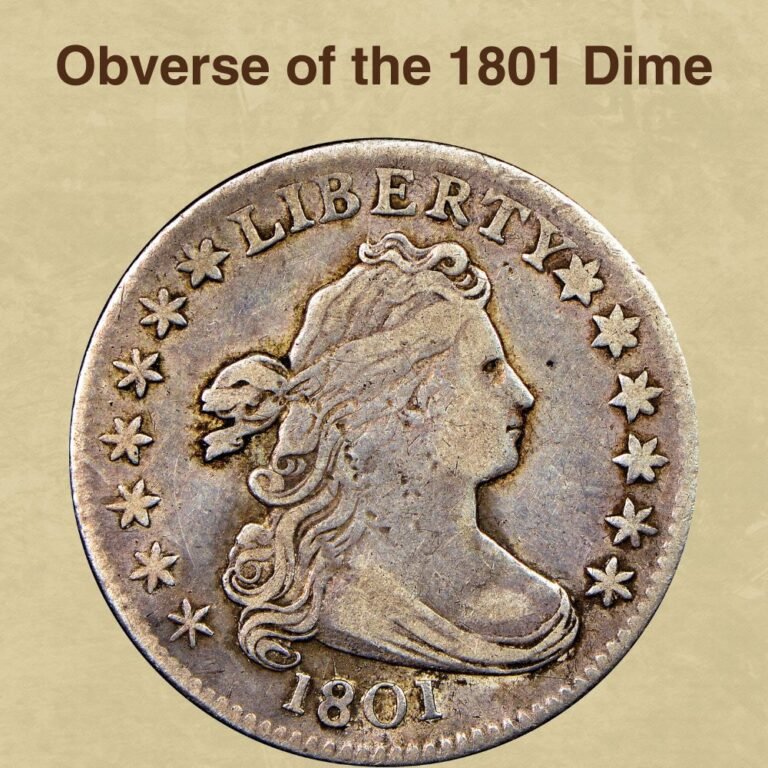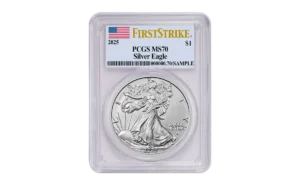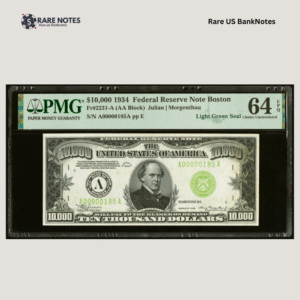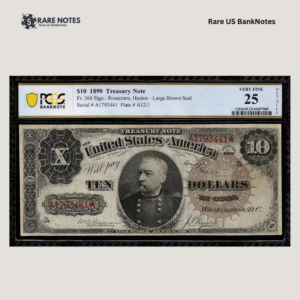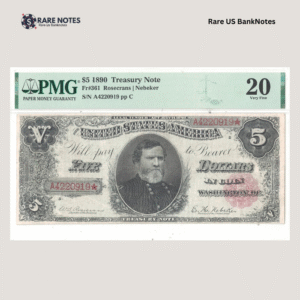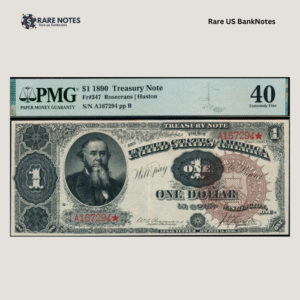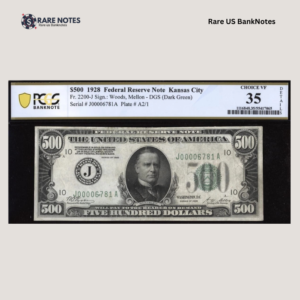The 1928 Half Dollar captures a unique moment in the beloved Walking Liberty series, produced during the prosperous final years before America’s economic transformation.
This date presents genuine challenges for collectors seeking premium condition examples due to limited surviving specimens in superior grades.While circulated examples remain accessible to most collectors, high-grade specimens command substantial premiums due to their scarcity and the series’ enduring popularity.
Let’s explore what makes these pre-Depression era half dollars particularly sought after by today’s collectors.
1928 Half Dollar Value By Variety
The following chart provides current market values for the 1928-S Half Dollar across different condition grades, helping collectors quickly assess their coin’s worth.
1928 Half Dollar Value Chart
| TYPE | GOOD | FINE | AU | MS | PR |
|---|---|---|---|---|---|
| 1928 S Half Dollar Value | $38 | $275 | $1,591 | $9,150 | — |
Tip: Use our CoinValueChecker App for real-time variety identification and current market values.
1928 Half Dollar Market Trend
Market Interest Trend Chart – 1928 Half Dollar
This market interest chart reveals compelling collector dynamics for 1928 Half Dollars spanning the past decade.
The early years demonstrate modest but consistent baseline activity with several notable spikes through 2015-2017, suggesting periodic discovery events or auction highlights that captured collector attention.February 2019 stands out as a watershed moment, featuring an extraordinary peak that dwarfs all other activity periods.
This dramatic surge likely reflects a confluence of factors—perhaps exceptional specimens appearing at major auctions, increased awareness of the date’s significance, or broader numismatic market momentum during this period.
The post-2019 landscape shows the market settling into more mature patterns, with sustained engagement levels significantly higher than the pre-2019 baseline. This elevated plateau suggests the 2019 surge successfully established 1928 Half Dollars as a recognized collecting priority, creating lasting awareness and demand.
Recent trends indicate healthy, steady interest with occasional upticks that reflect the coin’s established status among Walking Liberty enthusiasts. This stability often characterizes coins that have achieved recognition as legitimate key dates within their respective series.
For comprehensive analysis of how various coin series perform in today’s market and to discover which denominations currently lead collector interest, check out our complete US Coin Market Trend Ranking (Top 100) breakdown.
History of the 1928 Half Dollar
The 1928 Half Dollar emerged during one of the most optimistic periods in American history, capturing the exuberant spirit of the Roaring Twenties at its absolute peak.
This coin represents more than just currency—it embodies the confidence and prosperity that defined the era before the economic upheaval that would soon reshape the nation.
The year 1928 found America riding an unprecedented wave of economic expansion. Stock prices soared to record heights, consumer confidence reached new peaks, and the nation basked in what seemed like limitless prosperity. Jazz music filled the airwaves, automobiles transformed daily life, and technological innovations promised an ever-brighter future.
Against this backdrop of national optimism, the U.S. Mint continued producing Adolph Weinman’s magnificent Walking Liberty design, first introduced in 1916.
The Walking Liberty Half Dollar had already established itself as one of America’s most beloved coin designs by 1928. Weinman’s artistic vision—featuring Liberty striding confidently toward the dawn while draped in the American flag—perfectly captured the nation’s forward-looking spirit. The reverse, with its majestic eagle perched on a mountain crag, symbolized America’s strength and natural grandeur.
However, 1928 would prove to be the calm before the storm. Within months of these coins entering circulation, the stock market crash of October 1929 would shatter the nation’s economic dreams and usher in the Great Depression.
This historical context transforms the 1928 Half Dollar into a poignant reminder of America’s last moments of unbridled optimism before confronting its greatest economic challenge.
The coin’s production occurred exclusively at the San Francisco Mint, reflecting the regional minting practices of the era. These half dollars circulated widely throughout the country, changing hands in a bustling economy where silver coins held significant purchasing power and represented real value in everyday transactions.
Also Read: 10 Most Historic Years of Walking Liberty Half Dollar (1916-1947).
Is your 1928 Half Dollar rare?
1928 S Half Dollar
The 1928-S Half Dollar achieves a rarity score of 81, earning “Mythic” classification that ranks it 13th among all Walking Liberty Half Dollar issues.
This position places it in the challenging tier that typically requires significant financial commitment and separates casual collectors from serious numismatists.
The high rarity position results from a logical chain of scarcity factors that compound over time. The scarcity begins with production circumstances: San Francisco operated as the sole minting facility for 1928 half dollars, creating immediate limitations on total availability.
Economic conditions then intensified the rarity. The approaching Depression led to widespread coin hoarding and melting, while few collectors preserved specimens during the financial crisis that followed.
Survival patterns reinforce this scarcity. The “Mythic” classification indicates survival rates typically below 1% of original mintage, with high-grade examples representing mere fractions of remaining populations. These quantifiable metrics drive the ranking system rather than subjective assessments.
Collectors can access detailed survival statistics and comparative analysis through the CoinValueChecker App to understand these rarity dynamics across the complete series.

For comprehensive scarcity analysis showing how all Walking Liberty dates compare in survival rates and market accessibility, explore our complete Walking Liberty Half Dollar Rarity Ranking (Top 100).
Key Features of the 1928 Half Dollar
The 1928-S Half Dollar represents the final year of 1920s prosperity production, featuring design elements that showcase the mature development of Adolph Weinman’s Walking Liberty motif.
These coins display characteristics that reflect both the artistic excellence of the series and the production challenges unique to San Francisco minting during this pivotal historical period.
The Obverse of the 1928 Half Dollar

The obverse presents Liberty in full stride, moving confidently toward the rising sun with her right arm extended in a gesture of welcome and invitation.
Her flowing gown and the American flag draped around her create dramatic movement that captures the optimistic spirit of the era. The intricate folds and details in the fabric demonstrate Weinman’s sculptural mastery, though San Francisco’s striking quality during this period sometimes resulted in softness in the finest details.
“LIBERTY” curves along the left border, with Liberty’s figure actually obscuring portions of the lettering—a deliberate design choice that emphasizes the prominence of the allegorical figure.
“IN GOD WE TRUST” appears above Liberty’s trailing foot, while the date “1928” is positioned below her striding form.
The relief shows excellent depth and proportion when well-struck, creating visual appeal that has made this design enduringly popular among collectors. However, the complex design proved challenging for consistent reproduction, particularly affecting detail retention in Liberty’s outstretched hand and the flag’s intricate folds.
The Reverse of the 1928 Half Dollar

The reverse features a majestic bald eagle perched on a rocky mountain crag, wings partially spread as if preparing for flight.
A small mountain pine sapling grows from the rocky outcropping beside the eagle, symbolizing America’s natural resilience and growth. The composition creates a sense of strength and permanence that complements the forward movement of the obverse design.
“UNITED STATES OF AMERICA” arcs along the upper rim, while “E PLURIBUS UNUM” appears to the left of the eagle. The denomination “HALF DOLLAR” spans the bottom of the coin. Weinman’s initials “AW” can be found beneath the eagle’s right wing, though they often appear faint on circulated examples.
The “S” mintmark is located at the lower left of the reverse, positioned at approximately 7:30 on the clock face. San Francisco used two different mintmark punches during 1928 production, creating small and large “S” varieties, though neither commands significant premium over the other.
Other Features of the 1928 Half Dollar
The 1928-S maintains the standard Walking Liberty specifications: 90% silver composition with 10% copper, weighing 12.5 grams with a diameter of 30.6 millimeters. The edge features reeding, consisting of vertical lines around the coin’s circumference that both prevented clipping and provided tactile identification.
1928 Half Dollar Mintage & Survival Data
1928 Half Dollar Mintage & Survival Chart
Survival Distribution
| Type | Mintage | Survival | Survival Rate |
|---|---|---|---|
| S | 1,940,000 | 95,000 | 4.8969% |
The 1928 Half Dollar production reflects the unique circumstances of its single-mint issuance, with San Francisco serving as the sole production facility. The mintage of 1,940,000 pieces represents a moderate production run that would prove insufficient to meet long-term collector demand.
Current survival statistics reveal approximately 95,000 specimens remaining in collectible condition, yielding a 4.8969% survival rate.
This relatively high survival percentage compared to other Walking Liberty issues reflects several factors: the coin’s production during peacetime conditions, its timing before the most intensive wartime metal drives, and the beginning awareness among some collectors of the series’ numismatic potential.
However, survival rates tell only part of the story. The distribution heavily favors lower grades, with high-quality specimens representing a small fraction of surviving coins. The economic turmoil following 1929 led to extensive circulation and limited preservation efforts during the Depression years.
The survival data positions the 1928-S within specific collecting parameters, where availability in circulated grades contrasts sharply with scarcity in premium condition. Understanding these survival patterns across all dates helps collectors identify the most challenging issues to acquire.
For comprehensive analysis of how survival rates compare across the complete series and to identify the scarcest half dollars in collectible condition, explore our detailed Walking Liberty Half Dollar Survival Ranking (Top 100).
1928 Half Dollar Grading
Understanding the 1928-S Half Dollar’s grading challenges begins with recognizing its unique production characteristics.
The San Francisco Mint’s conditions during this period often resulted in incomplete strikes even on uncirculated examples, making fully detailed specimens particularly valuable and affecting how graders evaluate condition.
The standard 70-point Sheldon Scale provides the grading framework, with particular attention required for strike quality and surface preservation on this challenging date.
Critical assessment focuses on key diagnostic areas including Liberty’s extended right hand, which frequently shows weakness from the striking process, and the eagle’s breast feathers and leg details that serve as primary strike indicators.
Surface quality evaluation reveals circulation history and determines whether specimens fall into circulated or uncirculated categories – a distinction that often represents substantial value differences. Accurate grading determines the vast difference between modest collector premiums and significant investment-level values for the 1928-S Half Dollar.
Common grading obstacles include environmental damage, cleaning evidence, and contact marks that significantly impact final grades, often reducing values across multiple grade levels.
In mint state designations, surface luster, color retention, and eye appeal factor heavily into final grades, where market premiums escalate rapidly with each increment.
Collectors can perform preliminary grade evaluation using the CoinValueChecker App to establish baseline condition assessment before pursuing professional certification. This initial analysis helps identify potential grade ranges and value expectations.

For comprehensive guidance on evaluating Walking Liberty design elements and understanding wear patterns that affect condition assessment, explore our detailed tutorial on How to Grade Walking Liberty Half Dollar.
1928 Half Dollar Value Guides
- 1928-S Half Dollar
The 1928-S is a key date in the Walking Liberty series due to low mintage and striking issues. This San Francisco mint coin carries premiums in all grades, with even worn examples trading above silver value. Well-struck specimens are particularly scarce and valuable, making this date highly sought after by collectors.
1928-S Half Dollar Value

The 1928-S Half Dollar was struck at the San Francisco Mint with a mintage of 1,940,000 pieces.
This issue exhibits characteristic striking weaknesses that affected most examples, typically displaying flattening of details in Lady Liberty’s extended hand as well as the reverse eagle’s breast feathers and legs.Collection challenges arise from these widespread striking problems, making sharply detailed specimens scarce.
The coin remains available through AU grades but becomes genuinely scarce from MS60-MS65, with MS66 representing exceptional rarity. Only 15 examples have achieved MS66 certification, with a recent MS66 bringing $31,200 in May 2025.
The 1928-S also displays distinctive toning characteristics, with most uncirculated examples showing some degree of attractive color alongside strong luster.
These grading difficulties, combined with limited collector saving during this era, create significant rarity in higher grades. This scarcity is reflected in current pricing, where higher grade examples command substantial premiums over lower grades.
1928-S Half Dollar Price/Grade Chart
Price by 1-70 Grade (Latest Auction Records Included)


